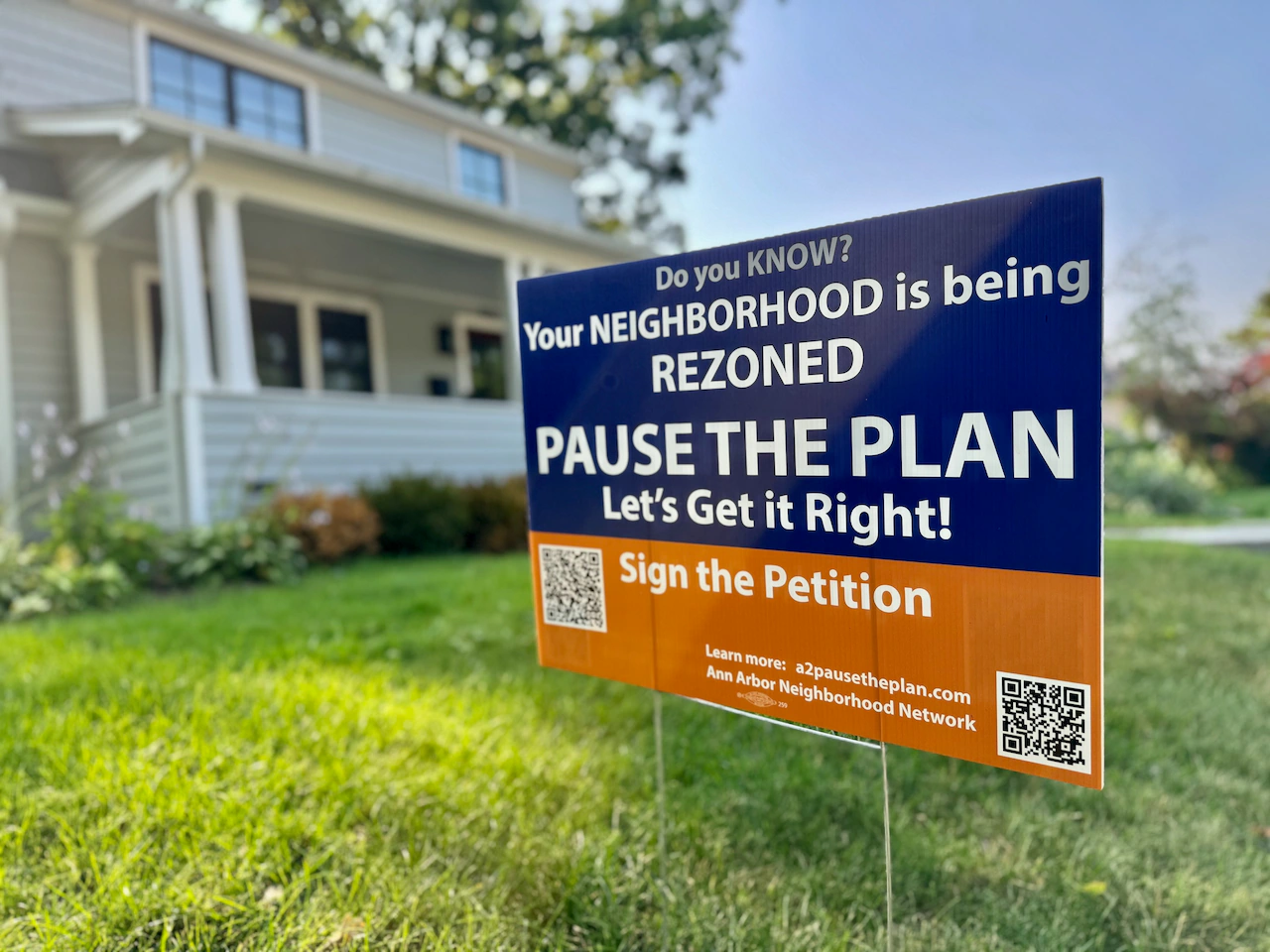Copyright M Live Michigan

ANN ARBOR, MI — Brockman Boulevard resident John Godfrey appeared before the Ann Arbor City Council with a thick stack of papers Monday night, Oct. 20. “This is a petition to suspend the planning process and to restart it with genuine involvement from residents across all neighborhoods of the city,” said Godfrey, a member of the “Pause the Plan” coalition opposed to the city’s plan for increased housing density. “Over 3,600 actual Ann Arbor residents have so far attached their names to this petition,” he said. His group has taken pains to remove duplicate signers as some people have been zealous and added their names multiple times, he said. “But I’m very disturbed because zealous advocates for the plan that’s been proposed have added numerous obscene and fake names from popular culture,” he said, describing it as an attempt to sabotage the petition. “We have scrubbed these, so you will not be seeing them, I hope.” Godfrey was among several residents for and against the plan who spoke out before council voted 10-0 to release a third draft for a formal public review and comment period expected to last until Jan. 5. The plan envisions zoning changes to allow more housing throughout the city, including up to three-story, three-unit condo and apartment buildings in low-rise neighborhood areas where in many cases only single-family homes have been allowed, plus higher-density development downtown and along key corridors. While city leaders maintain the plan has been developed with extensive public input, Godfrey argued there was never any official notice sent to all residents and the city has not conducted a statistically representative survey to understand residents’ concerns and priorities. “This process has consistently lacked transparency, inclusivity and democratic fairness,” he told council. Council members once again pushed back on the claims. “The city’s formal engagement process to develop this plan started in the summer of 2023, over two years ago, with a series of stakeholder interviews,” said Mayor Pro Tem Travis Radina, D-3rd Ward. “Through the end of 2024, there were over 43,000 views on the project website, over 3,100 survey responses, more than 580 people had attended eight community engagement events at our libraries and 12 additional pop-up events had occurred.” Council members and the mayor since have hosted ward-specific town halls, encouraged residents to participate in the process through council newsletters mailed citywide and have participated in resident-organized neighborhood meetings, Radina said. Planning commissioners and council members also have heard a wide range of public feedback at their regular meetings. Throughout the process, council and the commission have listened to thousands of community members with a wide range of views, Radina said. After a first plan draft was released this spring, they listened to the public more and made changes, he said, and then again with a second draft. The third draft includes council-imposed limits on neighborhood density that are more restrictive than some planning commissioners and density advocates wanted. “For many, this draft of the plan does not go far enough toward allowing housing abundance,” Radina said. “For some, it feels just right. For others, this plan goes too far. And for others still, there’s a desire to stop any new plan altogether.” Radina said he campaigned for council to address a housing affordability crisis. “Despite what we have heard from some, allowing more housing does, in fact, impact housing costs,” he said. “Just this month, I’ve had conversations with local landlords who have suggested that for the first time in years, they have vacancies in some of their buildings and they may not be able to raise or increase rents as much as they would like.” Radina said he will continue to support a plan that allows for more housing diversity and increased density where it makes sense, along major transit corridors, by Briarwood Mall and downtown, plus gentle growth in neighborhoods. Council Member Erica Briggs, D-5th Ward, said it was great to see the council chambers packed with residents Monday night and she knows people have strong feelings. “I recognize that probably everybody in this room has things that they love about the plan, and things that they wish were in the plan, or wish that they weren’t in the plan,” she said. She described it as “something that we’ve developed together as a community,” with ideas about where the city should head in the next 25-plus years. Briggs said there were talks about starting work on the plan when she was elected in 2020, but the process was paused then due to the COVID-19 pandemic. “We’ve been having this conversation for quite some time,” she said. “Our land-use plan is 30 years now out of date in some places. The idea that we would pause it at this point is not reasonable to me.” There will be continued public engagement and opportunity for input as the process moves forward, heading toward plan adoption in early 2026, followed by years of zoning ordinance work to gradually implement the plan, officials said. City planners intend to have an online form on the “A2 for All” project webpage to solicit comments during the review period council voted to start Monday night. Council Member Lisa Disch, D-1st Ward, said because many people feel public input hasn’t been heard, she wanted to point out some of what has been worked into the plan. Clarification of the relationship between the plan and implementation through zoning can be found on page 110, she said, and it talks about the terms for infill development in residential districts on pages 113 and 116. Page 23 talks about how the University of Michigan’s growth has created housing market pressures, she said, and starting on page 118 university-related housing has been added to the primary uses for higher-density transition and hub districts. There is a recommendation to explore expedited permitting for duplexes and triplexes in residential districts, Disch said, pointing to plan implementation steps starting on page 136. She also pointed out page 62 acknowledges zoning reform alone is insufficient to spur the development of “missing middle” housing. In addition to streamlining the development review process, the city needs to be willing to use financial and other incentives to stimulate that type of construction, the plan states. “Thank you, Mr. Dohoney, I’m sure that we’ll get a giant budget allocation for that,” Disch said with a laugh, directing her comments toward City Administrator Milton Dohoney. Disch noted page 142 of the plan also recommends a focus on the “quality, equity and ecological benefit in the development of new open space,” mentioning natural features such as woodlands and wetlands on private property to be considered for protection, restoration and mitigation as part of site plan reviews. “Which would be an extension of our current natural features ordinance,” Disch said. Want more Ann Arbor-area news? Bookmark the local Ann Arbor news page.



